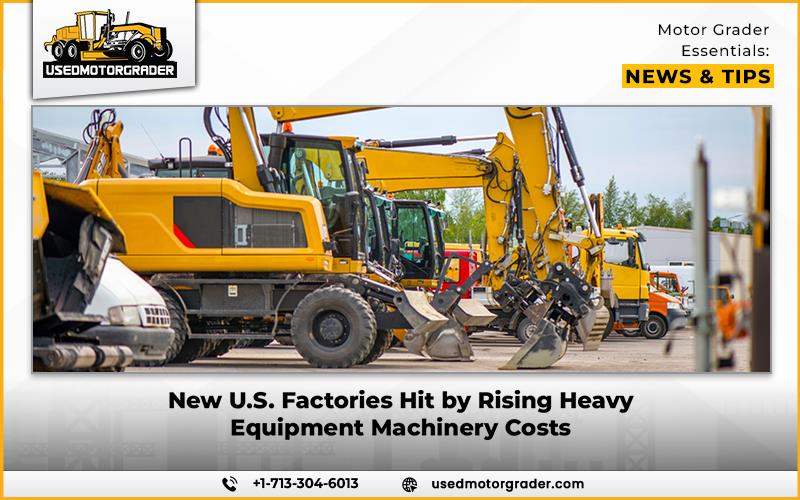In 2025, the heavy equipment and construction industries are in the crossfire of changing global trade policies. The most recent set of tariffs imposed by the U.S. government, directed toward reducing imports and stimulating domestic manufacturing, has resulted in unforeseen outcomes for manufacturers to grow their businesses. Although the purpose is to make American industry stronger, the result for many equipment purchasers and factory owners is increased cost and reduced budgets.
The shift in the current policies has severely impacted the business and manufacturing companies. Heavy equipment machinery is no exception; along with other large sectors, these manufacturing firms are also impacted.
Heavy Equipment at the Heart of the Problem
Constructing a new factory is a capital-intensive undertaking. From grading and earthmoving to foundation construction and steel erection, the entire process relies on heavy machinery. For example, bulldozers, excavators, cranes, and wheel loaders accomplish tasks efficiently. However, tariffs increase the cost of imported steel, heavy construction equipment components, and even entire machines. Contractors and manufacturers are finding their budgets significantly exceed initial estimates.
For instance, most Tier 1 equipment producers import key hydraulic components, engines, and electronic controls from abroad. When tariffs affect these components, costs ripple throughout the supply chain. A 2023 mid-sized excavator priced at $ 180,000 can now cost over $200,000 as input prices increase. When projected across an entire fleet of equipment for a factory site, this results in millions in unexpected costs.
The JCB Example: Scaling Up Amid Rising Costs
JCB moves forward with the construction of its extensive new manufacturing center located in San Antonio, Texas. The British-based equipment manufacturer started with an initial plan of building a $265 million facility employing 720 people, yet expanded the proposed site from 500,000 to 1 million square feet. This manufacturing expansion happens becauseof U.S. tariffs combined with the need to produce products locally in the United States. Building facilities to counter tariffs produces financial difficulties for companies.
JCB established local production sites because they wanted to stay away from expensive import taxes on equipment coming from European facilities. The escalating costs for building this facility grow rapidly in an environment where concrete, steel, labor, and machines all have escalating prices. Companies such as JCB maintain their schedule and budget by issuing challenging decisions such as postponing particular construction phases. lease instead of buying equipment or even sourcing refurbished machinery to reduce capital expenditures.
Equipment Dealers Feel the Pressure
It’s not only the large manufacturers that are feeling the pinch. Equipment rental firms and dealers are also affected. With the OEMs’ increasing prices, new equipment is less affordable for the typical contractor or builder. That’s created a demand boom in the used heavy equipment machinery market, which has consequently driven up secondhand prices.
Dealers say backlogs are increasing. Machines that once took 2–3 months to arrive now take twice as long. This is especially the case for in-demand categories such as skid steers, wheel loaders, and compact excavators. For factory developers with tight deadlines, delays in receiving machines onsite can extend completion dates and drive up labor costs.
Tariffs on Steel and Electronics Create a One-Two Punch
The highest expense factor in production belongs to steel materials. The steel structure dominates factory construction while heavy equipment machinery such as cranes and dozers as well as loaders, contain extensive steel components. The new tariffs have led to a rise in steel ton price, which has elevated the total expenses for manufacturing materials alongside equipment manufacturing expenses.
Modern machines come with complex electronic systems that consist of telematics alongside GPS modules, engine monitoring systems, and autonomous functions. Aside from Asian suppliers, the production components primarily originate from international sources. The recent limitations on semiconductor imports as well as related technological items result in further expenses and delays for equipment manufacturing.
Domestic Manufacturing vs. Global Sourcing
A new strategic approach has emerged in response to changing tariff policies for numerous companies. Should businesses continue their imports of equipment and components during these times? Companies must decide between building their facilities in the United States despite higher construction expenses or continuing to import equipment and parts.
Donating manufacturing activities to U.S. facilities and nearby countries such as Mexico has become a strategy adopted by certain automotive manufacturers. The long-term advantages come with a turbulent transition phase that companies must endure. A new factory setup combined with workforce recruitment and building reliable supply chains needs ample time and financial resources, which present challenges in the booming construction industry and trade tensions.
Final Thoughts
The strategy to rebuild U.S. manufacturing is a lofty one—and probably unavoidable in a more and more uncertain world. But for the moment, the way forward is muddied by a complex web of increasing costs, equipment slowdowns, and tariff-fueled inflation.
For heavy equipment businesses, that translates to keeping up. From forming alliances with rental houses to investing in older machines, or from looking inward to domestic supply chains, agility will be the secret to survival during this economic change. Contractors and manufacturers both will have to sharpen their pencils, monitor the markets, and prepare for an era where equipment is not just a tool—but a strategic advantage in an environment of increasing expense.


